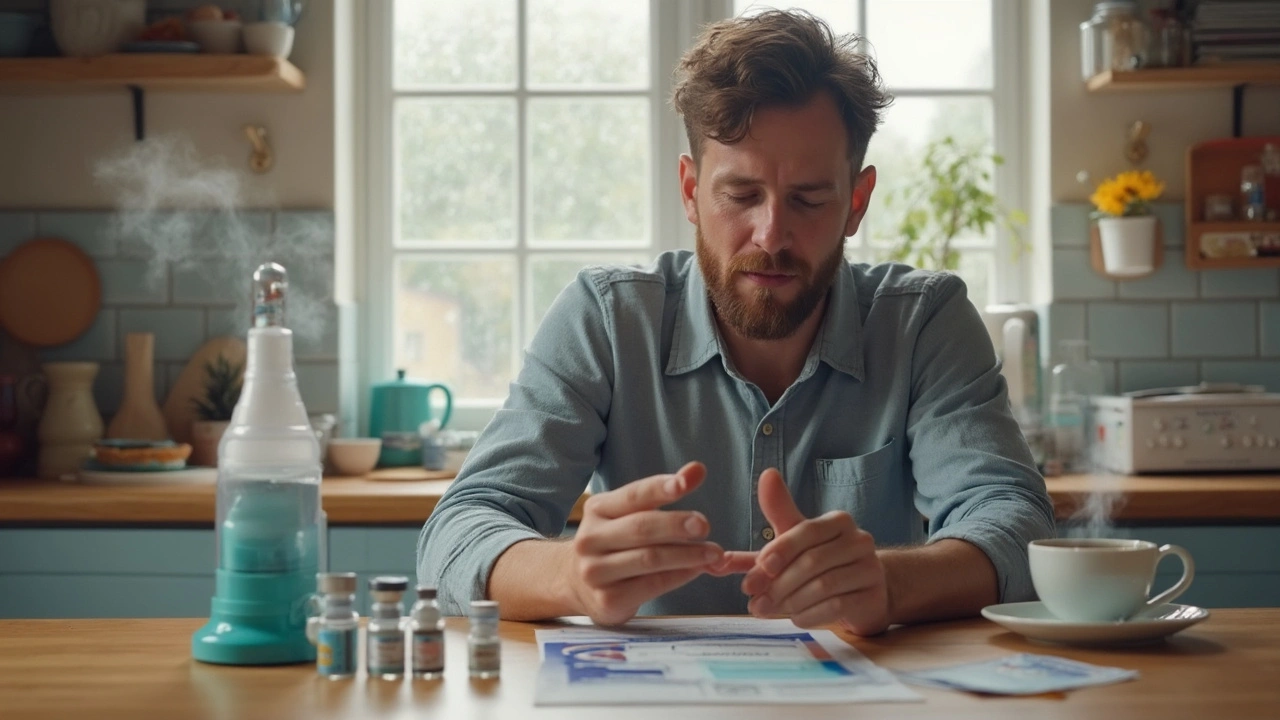Stuck without Ventolin and need quick relief? This guide unpacks over-the-counter nebulizer options available in the US, including saline solution, epinephrine ampules, and short-acting beta agonists you can snag without a full prescription. You'll get tips on how and when to use these solutions, what works for different kinds of breathing trouble, and how they stack up in safety and effectiveness. Practical advice, real-life caution, and the info you actually need for managing respiratory issues at home.
Saline Nebulizer: What It Does and Why People Use It
Want a simple way to loosen mucus, soothe irritated airways, or make breathing easier during a cold or flare-up? A saline nebulizer turns liquid salt solution into a fine mist you inhale. It’s often used for kids, people with chronic lung conditions, or anyone who needs extra airway moisture. You don’t always need a drug—saline alone can help clear secretions, reduce cough, and improve comfort.
Types of saline and when to pick them
There are two main saline types: isotonic (0.9%) and hypertonic (usually 3% or more). Isotonic saline is gentle and fine for regular use—good for babies, dry coughs, and daily airway hydration. Hypertonic saline draws fluid into the airway and can help thin thick mucus; it’s often used for sputum clearance in conditions like cystic fibrosis but can trigger coughing or wheeze. If you have asthma or reactive airways, ask a clinician before trying hypertonic saline—sometimes a bronchodilator is given first.
How to use a saline nebulizer safely
Start with the right equipment: a working nebulizer (compressor, mesh, or ultrasonic), a mouthpiece or mask, and sterile saline meant for nebulizers. Never use homemade saline or regular tap water. Follow these steps: 1) Wash hands. 2) Fill the nebulizer cup with preservative-free sterile saline to the fill line. 3) Attach tubing and mouthpiece/mask. 4) Sit upright and breathe normally until the mist stops (usually 5–15 minutes). If you cough a lot, take breaks and breathe slowly. For children, use a mask and keep them calm with a favorite video or toy.
How often? For everyday hydration, 1–3 times daily is common. For thick secretions or a doctor’s plan, frequency may be higher. Always follow your provider’s instructions. If you feel more short of breath, wheeze, or chest tightness after saline, stop and contact your clinician—bronchospasm is a possible side effect, especially with hypertonic saline.
Cleaning, storage, and safety tips
Clean the nebulizer after each use: disassemble, rinse parts (not the tubing) with warm water, and air dry on a clean towel. Once a day, disinfect parts per manufacturer instructions—usually boiling, vinegar soak, or dishwasher-safe steps. Replace filters and mouthpieces as recommended. Store saline vials sealed and discard any opened vial after 24 hours. Don’t mix medications into saline unless prescribed by a provider; some drugs need specific diluents or doses.
Want simple signs you should call a doctor? High fever, bloody mucus, sudden worsening breathing, or if saline makes you cough more and you can’t catch your breath. If you’re using a nebulizer long-term, schedule check-ins so your clinician can adjust treatment or test lung function.
Saline nebulizers are low-tech but effective when used right. Use sterile saline, keep gear clean, follow safety steps, and check with your healthcare provider before trying hypertonic solutions or mixing meds. Small habit changes—cleaning after use, sitting upright, and using the right saline—make a big difference in comfort and results.

